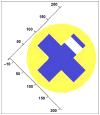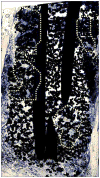Mathematical modeling and mechanical and histopathological testing of porous prosthetic pylon for direct skeletal attachment
- PMID: 19675985
- PMCID: PMC2905739
- DOI: 10.1682/jrrd.2008.09.0123
Mathematical modeling and mechanical and histopathological testing of porous prosthetic pylon for direct skeletal attachment
Abstract
This article presents recent results in the development of the skin and bone integrated pylon (SBIP) intended for direct skeletal attachment of limb prostheses. In our previous studies of the porous SBIP-1 and SBIP-2 prototypes, the bond site between the porous pylons and residuum bone and skin did not show the inflammation characteristically observed when solid pylons are used. At the same time, porosity diminished the strength of the pylon. To find a reasonable balance between the biological conductivity and the strength of the porous pylon, we developed a mathematical model of the composite permeable structure. A novel manufacturing process was implemented, and the new SBIP-3 prototype was tested mechanically. The minimal strength requirements established earlier for the SBIP were exceeded threefold. The first histopathological analysis of skin, bone, and the implanted SBIP-2 pylons was conducted on two rats and one cat. The histopathological analysis provided new evidence of inflammation-free, deep ingrowth of skin and bone cells throughout the SBIP structure.
Figures

























Similar articles
-
Recent Progress in Animal Studies of the Skin- and Bone-integrated Pylon With Deep Porosity for Bone-Anchored Limb Prosthetics With and Without Neural Interface.Mil Med. 2021 Jan 25;186(Suppl 1):688-695. doi: 10.1093/milmed/usaa445. Mil Med. 2021. PMID: 33499499 Free PMC article. Review.
-
Porous composite prosthetic pylon for integration with skin and bone.J Rehabil Res Dev. 2007;44(5):723-38. doi: 10.1682/jrrd.2006.12.0160. J Rehabil Res Dev. 2007. PMID: 17943684 Free PMC article.
-
Mechanical properties of totally permeable titanium composite pylon for direct skeletal attachment.J Biomed Mater Res B Appl Biomater. 2012 May;100(4):993-9. doi: 10.1002/jbm.b.32663. Epub 2012 Jan 30. J Biomed Mater Res B Appl Biomater. 2012. PMID: 22287509 Free PMC article.
-
New method of fixation of in-bone implanted prosthesis.J Rehabil Res Dev. 2013;50(5):709-22. doi: 10.1682/jrrd.2012.11.0202. J Rehabil Res Dev. 2013. PMID: 24013918 Free PMC article.
-
Design features of implants for direct skeletal attachment of limb prostheses.J Biomed Mater Res A. 2013 Nov;101(11):3339-48. doi: 10.1002/jbm.a.34606. Epub 2013 Apr 2. J Biomed Mater Res A. 2013. PMID: 23554122 Free PMC article. Review.
Cited by
-
Effects of pore size, implantation time, and nano-surface properties on rat skin ingrowth into percutaneous porous titanium implants.J Biomed Mater Res A. 2014 May;102(5):1305-15. doi: 10.1002/jbm.a.34807. Epub 2013 Jun 7. J Biomed Mater Res A. 2014. PMID: 23703928 Free PMC article.
-
Kinetics of individual limbs during level and slope walking with a unilateral transtibial bone-anchored prosthesis in the cat.J Biomech. 2018 Jul 25;76:74-83. doi: 10.1016/j.jbiomech.2018.05.021. Epub 2018 May 23. J Biomech. 2018. PMID: 29861094 Free PMC article.
-
A Prototype of a Neural, Powered, Transtibial Prosthesis for the Cat: Benchtop Characterization.Front Neurosci. 2018 Jul 13;12:471. doi: 10.3389/fnins.2018.00471. eCollection 2018. Front Neurosci. 2018. PMID: 30057524 Free PMC article.
-
Recording of electric signal passing through a pylon in direct skeletal attachment of leg prostheses with neuromuscular control.IEEE Trans Biomed Eng. 2012 May;59(5):1349-53. doi: 10.1109/TBME.2012.2187784. Epub 2012 Feb 13. IEEE Trans Biomed Eng. 2012. PMID: 22345523 Free PMC article.
-
Biocompatibility Analysis of the Silver-Coated Microporous Titanium Implants Manufactured with 3D-Printing Technology.Nanomaterials (Basel). 2024 Nov 22;14(23):1876. doi: 10.3390/nano14231876. Nanomaterials (Basel). 2024. PMID: 39683264 Free PMC article.
References
-
- Brånemark R, Brånemark PI, Rydevik B, Myers RR. Osseo-integration in skeletal reconstruction and rehabilitation: A review. J Rehabil Res Dev. 2001;38(2):175–81. - PubMed
-
- Pitkin M, Blinova MI, Yudintseva NV, Potokin IL, Raykhtsaum G, Pinaev GP. Skin and bone integrated prosthetic technology. I. Characterization and morphology of human cells cultivated on titanium implants of different structures [abstract]. Proceedings of the 9th Russian National Congress, People and Health; 2004 Nov 22–26; St. Petersburg, Russia. St. Petersburg (Russia): Russian National Congress; 2004. p. 217.
-
- Pitkin M, Raykhtsaum G, inventors. Skin integrated device. United States patent US. 20070071788. 2007. Mar 29,
Publication types
MeSH terms
Grants and funding
LinkOut - more resources
Full Text Sources
Medical
Miscellaneous
